Installing Avidemux on Ubuntu
Software name : Avidemux
Homepage : http://avidemux.sourceforge.net/
Software version used for this installation : 2.3
Operating System use for this installation : Ubuntu 7.10
Recommended Hardware : 500MHz CPU
Installing Avidemux on Ubuntu is fairly straight forward. First you need to configure what is known as the Package Manager for Ubuntu. The Package Manager is a program that assists you when you wish to install software.
Synaptic Package Manager
The Synaptic Package Manager (SPM) is used for more than just installing software. It can also upgrade your entire operating system, and manage all software installed on your computer. However most people use SPM for just installing new software. Before you embark on this process, there are a few concepts that you may wish to get familiar with. It's not crucial you understand them thoroughly, so just read the explanations and then let it soak in over time. The ideas behind SPM will become clearer with use.
What is a repository?
SPM can automate the installation of software on your computer because it has a direct connection to one or more online software repositories. These repositories are vast archives of programs that have been pre-configured for installation on your operating system. When your computer is online, SPM can connect to these archives, check what software is available for installation, and present you with a list of installable software. All you have to do is select the software from the list that you want. SPM then downloads the software from the repository and takes care of the installation process.
So SPM is actually a repository manager: it manages which repositories (there are many) you wish to access, and which programs to download and install from those repositories.
SPM allows you to choose which repositories it accesses through its settings. The default repositories used by Ubuntu can be extended through the SPM settings so you can access a wider range of programs. Ubuntu calls each repository by a simple name. They are: Main, Universe, Multiverse, Restricted. By default Ubuntu only uses the Main online repository. If you wish to access you the other repositories, you must do this by changing repository settings of SPM.
What is a package?
When SPM downloads a programs for installation, it is in the form known as a 'package'. This means that it is a compressed archive of the program, pre-configured so that it can install nicely on your computer. If the package has been configured nicely (and the Ubuntu project team spends a lot of time making sure this is the case), then many of the headaches that installing software can bring are taken away — it's the aspirin of software installation. One of the biggest issues with installing software on any form of Linux (Ubuntu is one of many types of Linux), is dependencies. Dependencies are all the other packages required by a particular package. If, for example, I want to install an audio editor, that audio editor software may use some functionality of other programs to do its job.
SPM takes the (often) dark art of dependencies away from you, and manages this itself. So if you wish to install a program and it has dependencies (and the list can be long), you don't have to work this out yourself. SPM knows already what is needed, finds it, and installs it along with the software you have chosen.
So, SPM, as well as managing which repositories you access, is also a package management software. Hence the name: Synaptic Package Manager.
apt
You don't really need to know about 'apt', so if you are on the verge of being confused then don't read this short section. If you are a geek wannabe, then read on.
Ubuntu is a form of Linux that has derived from another form of Linux called Debian. This family of Linux has in common (amongst other things) the package/repository management system. Both Ubuntu and Debian use the apt system for managing packages. APT is an acronym for Advanced Package Tool.
SPM is actually a 'front end' (graphical interface) for controlling 'apt'. So SPM is the nice user interface that you see, but the real work is done by 'apt'. There are other ways of managing 'apt', such as the command line interface known as apt-get. In the world of Linux, there are many varieties of Linux users and they have their own ways of doing things. In general it's safe to say most Debian users use apt-get, and most Ubuntu users are happier using SPM.
Configuring Synaptic Package Manager
To install most software on Ubuntu, you need to change the default repository settings of SPM, because many programs are not contained in the default repository. To do this, you need to open the Synaptic Package Manager, which you can do via the System menu. If you haven't changed the default Desktop of Ubuntu, then the System menu can be accessed at the top left of your screen:
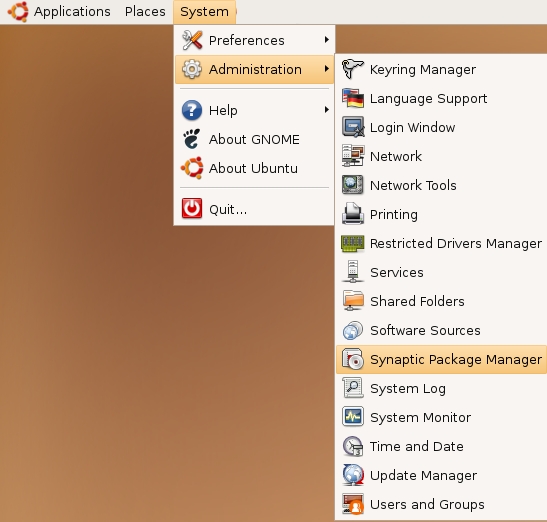
If all is good, you are prompted for a password.
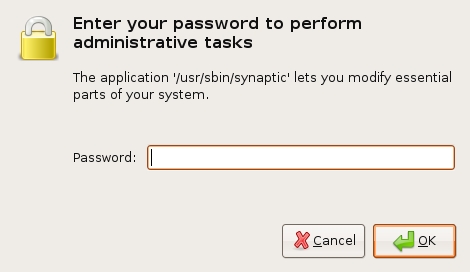
Here you must enter your password (the same one you use to log into the system). If you don't know the password, then you have a problem and it's probably caused by the fact that the computer you are using is not yours. In this case you have to find the computer's owners and ask them for the password (which is usually not polite unless you know them well) or ask them to input the password while you look casually in the other direction.
Assuming the password entered is correct, you now see the SPM open in front of you. It may be that you first see the following 'Quick Introduction' (which appears if you haven't used SPM before).

Just click Close and move on.
Let's look at the Synaptic Package Manager interface.
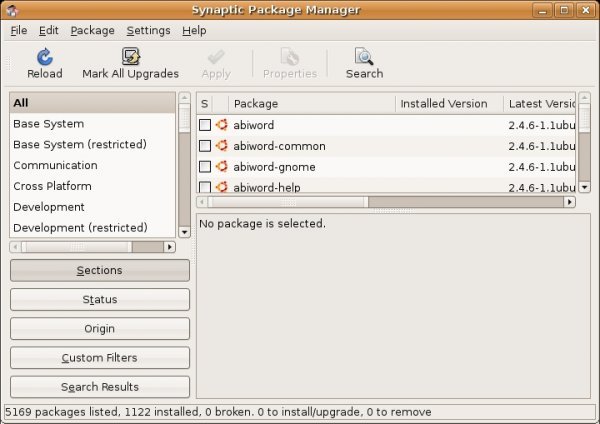
Let's not worry about the details of the interface for now. All we want to do is change the repository settings. To do this, on the Settings menu, click Repositories.

Now we get to where we can do some business. Make sure that all the options are selected:
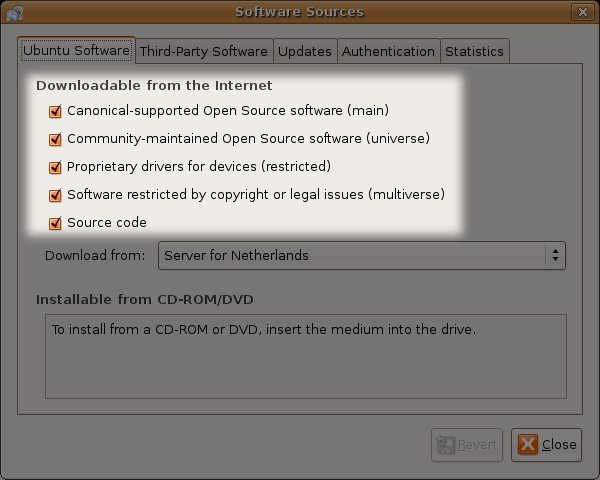
Now close that window by clicking the big Close button at the bottom right.
![]()
Next, you see a warning telling you the repository has changed:
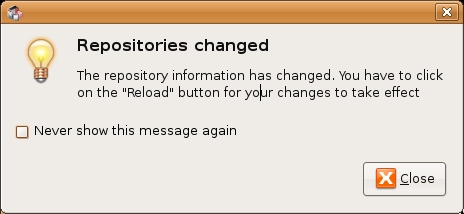
Click the Close button.
Back in the SPM interface, you need to refresh the repositories as the warning suggests. To do this, click Reload:
![]()
You then see a status window saying the repositories are being updated and showing the progress.
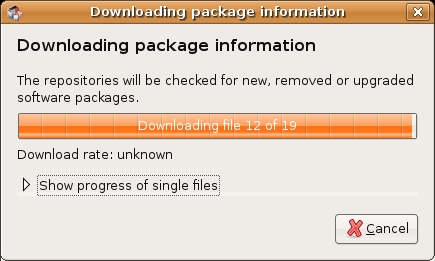
Installing Avidemux with Synaptic Package Manager
Now that you have Synaptic configured you can use it to install Avidemux. To do this click on the Search button in the Synaptic Package Manager interface. The search button looks something like this :

when you click on this button you see something like this:
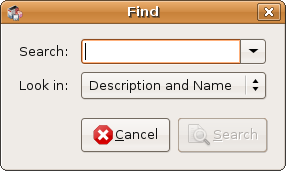
Now type 'avidemux' into the text field at the top:
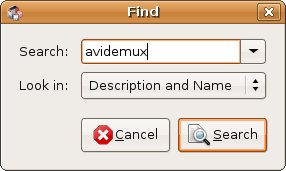
Now click on the 'Search' button you can see here, and you should see the Package Manager searching for your request. The final result will be that the small search window will close automatically and you will be left with the main Package Manager window displaying something like this:

If you see Avidemux listed with a little star by its name then you are good to go! You can now actually install the software. So, right click on the title of the software and choose 'Mark for Installation' :

This should present you with a little pop-up window :
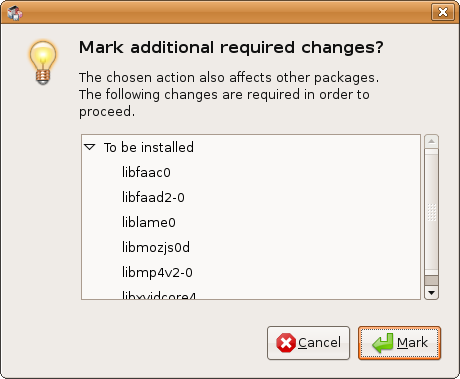
This lists all the software that must be installed so that avidemux can actually work. Don't be surprised if the list of software during your installation process to be installed looks different to the above list. Now, there is only one real choice here (as 'cancel' will stop the installation process) - click 'Mark'. When you do this the window will disappear and leave you, perhaps a little confusingly, with the main Synaptic Package Manager window again. It would probably be better if the Package Manager gave a little more feedback, but all things in time I guess...
Now you want to click on the 'Apply' button at the top of the window:
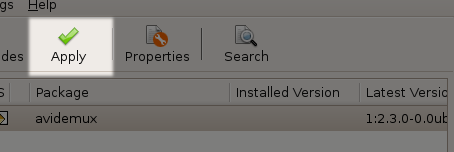
When you have clicked on this you be shown a confirmation window:
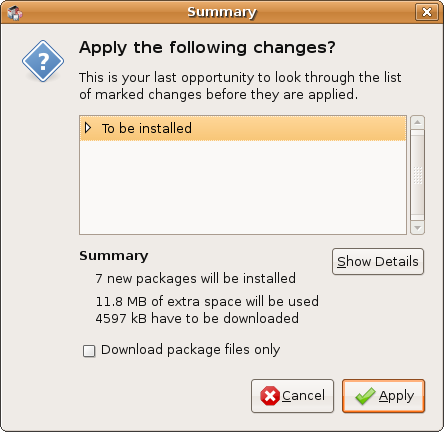
Just click on 'Apply 'once again and the download process will begin :
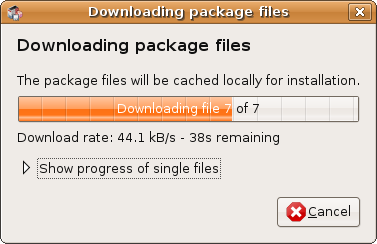
Followed by the installation process:
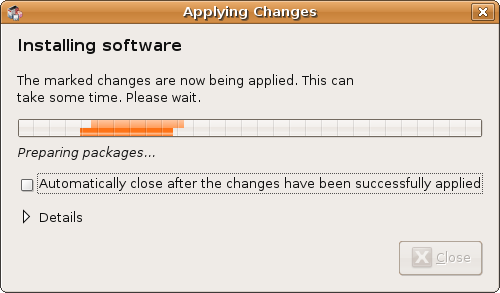
Then finally you will see a screen telling you all is complete :

You can now click on 'Close' and you will be left with a blank Synaptic Package Manager which you can quit :
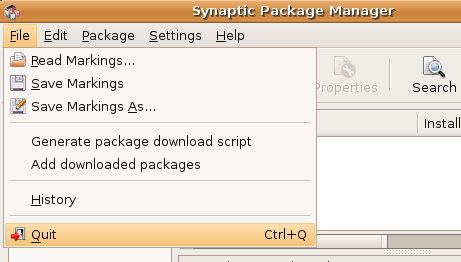
Starting Avidemux
Now that Avidemux is installed, you can might wish to try starting it. The nice interface designers at Ubuntu place newly installed software automatically in the drop down menus at the top of the desktop for easy access. So we just need to kick on 'Applications' then mouse down to 'Sound & Video' and you will see Avidemux listed :
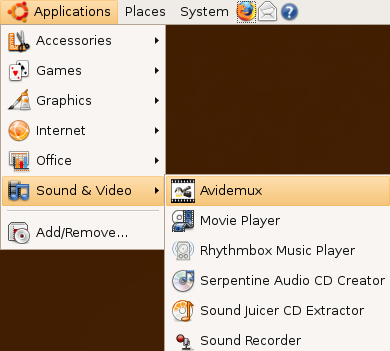
When you place you mouse over 'Avidemux' in the menu and release the mouse button you will see it open:






